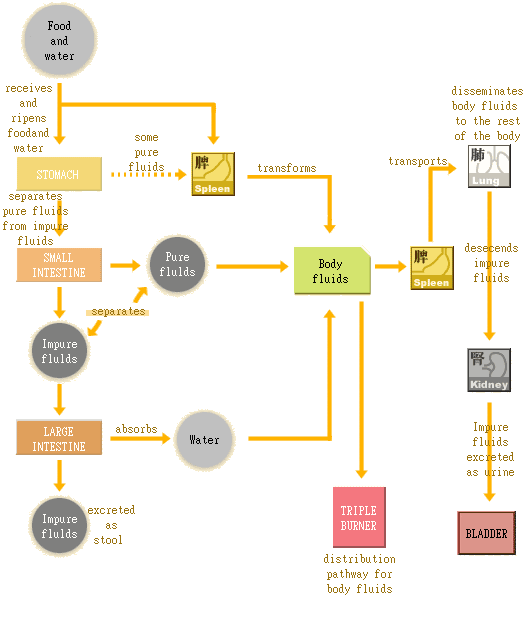|  |
|
| |
 |
 |
| Home > Basic Principles > The Fundamental Substances: Qi,Blood and Body Fluids > Body Fluids from a TCM Perspective |
 |
 |
 |
Body Fluids from a TCM Perspective
Body fluids refer to the different kinds of physiological fluids found in the body, including fluids in the organs and tissues, gastric fluid, intestinal fluid, semen and tears. Classified as one of the fundamental substances, body fluids are essential to life's activities.
The Origin, Distribution and Excretion of Body Fluids
According to TCM theory, body fluids originate from food and water. They are formed during digestion in the stomach and by transformation in the spleen. The small intestine extracts body fluids by further separating the pure fluids from the impure fluids contained in the food, and the large intestine contributes to the formation of body fluids by absorbing water from the stool.
Body fluids are distributed and excreted via different pathways. First, they are distributed through the spleen's transportation function to the lungs. In the lungs they are disseminated to the rest of the body. The lungs descend fluids that become impure while circulating through the body to the kidneys. The kidneys "vaporize" the body fluids and regulate their metabolism by sending the impure wastes to the bladder to be excreted. The triple burner also acts as a distribution pathway for body fluids.
Body fluids help excrete metabolic waste and toxins produced through the metabolic functions of various organs. These fluids are usually excreted as sweat and urine. In this way, body fluids maintain a clean and healthy environment for organs, meridians and tissues.
Functions of Body Fluids
Body fluids are mainly responsible for providing moisture and nourishment to the tissues. When distributed to the surface of the body, body fluids moisten the skin and hair and maintain the smooth and elastic texture of the skin. Body fluids also moisten, nourish and protect different orifices in the body. For example, body fluids allow the eyes to blink smoothly, the nasal cavity to maintain an open airway without blockage and the lips and mouth to remain moist without becoming dry. Internal body fluids also penetrate different organs, tissues and even bone marrow to provide moisture and nourishment. The spinal cord and brain are examples of organs surrounded by body fluid that protects and nourishes them.
Disharmony of body fluids is manifested in two ways. When body fluids can no longer nourish and provide moisture to the body, symptoms such as dry skin, flaccid muscles, brittle hair, dry eyes, parched lips and a dry nose or throat occur. When there is dysfunction of distribution or excretion of body fluids symptoms can present as swollen eyelids, edema (retention of fluid in the tissues), obesity or other conditions.
|
| Flow chart for formation of body fluids |
 |
|
References :
1. 張恩勤:《中醫基礎理論》〈上冊〉,上海 上海中醫藥大學出版社,1990。
2. 劉家義等:《中醫診斷學》,上海 上海中醫藥大學出版社,1990。
3. 北京中醫學院:《中醫學基礎》〈第一版〉,上海 上海科學技術出版社,1978。
4. 印會河:《中醫基礎理論》,上海 上海科學技術出版社,1985。
5. 《黃帝內經素問》,北京 人民衛生出版社,1978。
6. 劉燕池:《中醫基礎理論問答》〈第一版〉,上海 上海科學技術出版社,1982。
7. Kaptchuk Ted J.,Chinese Medicine :The Web That Has No Weaver, London: Rider, (2000).
8. Williams Tom, Complete Chinese Medicine, Bath: Mustard, (1999).
Written By:
Dang Yi
Professor, Beijing University of Chinese Medicine
Ph.D. Beijing Union Medical College
Vice Director, Gourmet Food Institute of Health Care and Nutrition of Beijing
Edited By:
Angelo Chung, B Pharrm., Integrated Chinese Medicine Holdings Ltd.
Angela Collingwood, MSN, Integrated Chinese Medicine Holdings Ltd.
Margaret Harris, MD, Integrated Chinese Medicine Holdings Ltd.
Translated By:
Michael Yang |
|
|
 |
|
|
 |